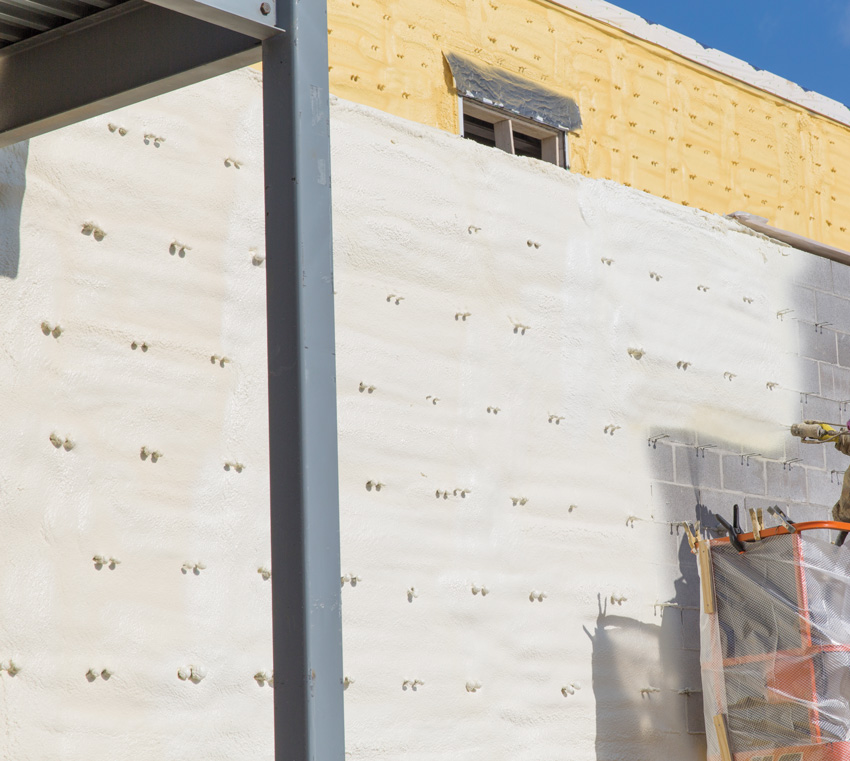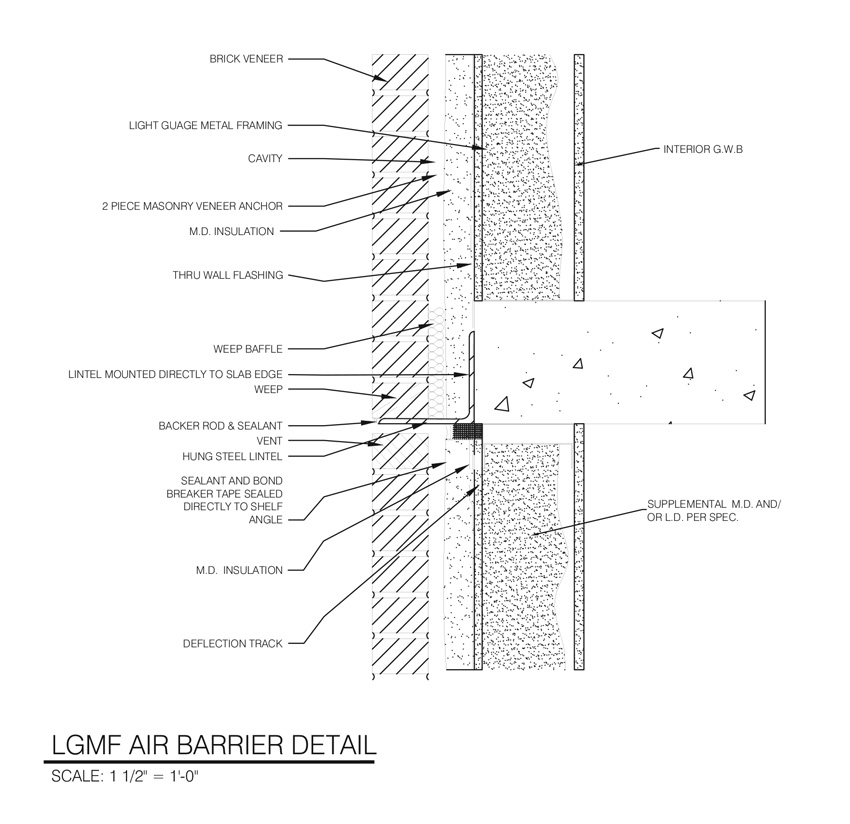Moisture Control with Spray Foam Insulation
Wall Assembly Integration
Of course, the method of securing and attaching cladding material needs to be acknowledged. Connectors or anchors for attaching cladding, whether for thin systems such as metal or fiber cement or thicker systems such as ties for brick and masonry, can be a factor in the wall assembly. Rigid foam boards are commonly available in 2-foot widths for the purpose of fitting above and below, such connectors or anchors that are spaced 2 feet apart vertically. Often, that means that there can be a horizontal gap along the joints of the foam boards, which compromises the full insulating performance of the system. This can be exacerbated if there are unusual details or irregular shapes along the wall, which alter the spacing of the cladding connectors and result in imprecise field cutting of the insulation. Spray foam insulation, on the other hand, covers and seals around all connectors and attachments completely. There is also greater flexibility with regard to attachment placement and configuration since a slightly bent or misaligned anchor can still be sprayed around without requiring realignment. This all minimizes the disruption in the continuity of the insulation, reducing it to only the actual thickness of the attachment materials.

Medium-density, closed-cell spray foam insulation adheres to substrates and seals completely around cladding anchors, such as brick ties and other penetrations.
Overall, medium-density spray foam covers the wall construction completely and creates a much more uniform layer of continuous insulation and barrier against air and weather. In the process, it seals completely around cladding attachments as well as covers over all of the joints and seams of substrates, such as exterior gypsum board. When applied around windows and doors, it makes smooth, continuous, and well-sealed transitions at heads, sills, and jambs, while conforming to flashings and other transition membrane components. If the walls have curved or other non-rectilinear shapes, the on-site spray application is ideal in that it can conform to any shape or feature of the wall system. Finally, manufacturers have recognized the need to demonstrate fire resistance and have successfully tested medium-density, closed-cell insulation in wall assemblies as part of showing code compliance for fire ratings.
Thermal Resistance
Spray foam products are most commonly known for their insulating properties, which is appropriate since they provide an excellent solution for insulating buildings thoroughly and completely. In buildings that use framed exterior walls constructed of either metal or wood studs, it is common to think in terms of insulating between the studs. But each of those studs is a break in the insulation that collectively can reduce the thermal performance of the wall by 20, 30, or even 50 percent. This is because the studs and other elements no longer have the thermal resistance of the insulation but instead act as a thermal bridge, allowing heat to flow more freely between inside and outside. Add in the thermal bridges that occur along floor lines or around major structural elements, such as columns, beams, piers, etc., and it is clear that a truly energy-efficient building needs a different approach to insulation.
Based on the above, the principle of continuous insulation in the building enclosure has been adopted in building codes, voluntary standards, and best practices. In exterior wall systems, that typically means a layer of exterior continuous insulation is installed outside of the exterior wall sheathing such that it covers over the outer surface of everything behind that sheathing too—the studs, the floors, the structure, etc. This dramatically increases the effective thermal performance of a wall since all or most thermal bridging is eliminated. Furthermore, the temperature of the framed wall and structure can approach the temperature of the living space if the right amount (thickness) of continuous insulation is used. That means that during cold outdoor conditions, most or all of the wall will be not only warm, but more likely to remain dry since condensation will not likely occur. During hot outdoor conditions, a majority of the wall will be dry and cool. Such environmental conditions translate into a wall under less long-term temperature and moisture stress, which leads to greater more durability and longevity of the wall.
Vapor Barriers
There is an additional benefit of having full exterior continuous insulation using closed-cell foam, particularly in cold climates. The codes recognize that insulated walls need an interior vapor barrier/retarder to prevent warm, moist air from entering into the wall assembly, condensing, and causing the potential for damage, rot, mold, or other issues. The type of vapor retarder required or prohibited by the code is based on the climate zone where the building is located and the classification listed in the codes based on perm ratings and material. The lower the perm rating, the less water vapor that passes through the material. The code classifies vapor retarders as follows (per 2015 International Building Code [IBC] Section 1405).
- Class I vapor retarders have a very low perm rating of less than or equal to 0.1 and include materials such as sheet polyethylene or non-perforated aluminum foil.
- Class II vapor retarders have a moderate perm rating greater than 0.1 but less than or equal to 1.0, as found in kraft-paper-faced fiberglass batts or certain vapor-barrier-tested paints and closed-cell spray foam insulation.
- Class III vapor retarders have a higher perm rating of greater than 1.0 but less than or equal to 10.0 and are common of most latex or enamel paints.

Low-permeability spray foam is recognized by building codes to have vapor-barrier qualities that can reduce the need for other interior vapor retarders.
The code goes on to say that there are exceptions to the otherwise required Class I or Class II vapor retarder in colder climates. One of those is the use of minimum R-value levels (based on climate zone) of continuous insulation on the outside of a framed wall. Further, it specifically states that “only Class III vapor retarders shall be used on the interior side of frame walls where foam plastic insulating sheathing with a perm rating of less than 1 is applied…on the exterior side of the frame wall,” (2015 IBC Section 1405.3.2). Note that in this code section, medium-density SPF is considered equivalent to foam plastic insulating sheathing and also applies here. In essence, this language is saying that there is no need, in fact there might be harm, in using a higher-rated Class I or Class II vapor retarder in walls that have foam insulation that already provides that attribute. Since medium-density, closed-cell spray foam insulation applied on the outside (or inside) of the exterior sheathing meets this criteria, there is no need for anything but common latex paint or the equivalent on the inside, finished surface of the wall. This not only means that there is less concern about moisture condensation inside the wall assembly, it also means that the wall has more potential to dry out quickly in the event any wayward moisture does make it there since wall drying is permitted both to the interior and exterior.
Water and Moisture Control
Exterior wall cladding materials (whether masonry, metal, composites, or others) typically do not completely prevent moisture or rainwater from entering into a wall. Some cladding materials are porous, while those that aren’t commonly have seams or joints that are limited in their ability to keep out water. In fact, some systems, which are commonly referred to as rainscreen cladding systems, are specifically designed to allow water to enter behind the cladding and drain harmlessly away out of the bottom. While this is good for the cladding, it may not be good for the rest of the wall if it isn’t properly treated. That is why building codes require a weather-resistive barrier behind cladding to protect the integrity of the rest of the assembly and prevent degradation of building materials due to rust, corrosion, rot, etc. In practice, this barrier really ends up needing to resist water, and spray foams are tested on their ability to function as a water-resistive barrier. For purposes of this article, while we are addressing both water and air infiltration resistance, we will stay with the insulation-testing definition of “water-resistant barrier,” abbreviated as WRB.
A number of sheet, roll, and spray-on products have been developed to provide the requisite performance of a WRB. Each of those products have their own limitations, including their own seams or joints, the need for a separate construction step, and the ability to be compatible with other wall materials and products.
SPF as a Water-Resistant Barrier
Medium-density, closed-cell spray foam products have been tested as WRBs and demonstrated that they are capable of shedding water and limiting moisture intrusion. Many such products have been evaluated according to the code requirements and criteria for WRBs, and are officially designated as water-resistive barriers accordingly. Since there are no joints to tape or overlapping practices to maintain, water-barrier performance is more easily assured on the construction site with spray foam insulation since it forms a continuous layer. In this case, not only is exterior continuous insulation provided, but water that penetrates past the cladding system and is forced by pressure toward the interior meets the spray foam’s exterior surface. The water-resistive nature of the medium-density spray foam is such that this water will drain down along the surface and not continue progressing into the wall assembly where it could cause damage. Such a moisture control system is particularly important to have in coastal or high-precipitation areas where driving rain is common.
Of course, the exterior wall needs to be designed to ensure that this water is actually diverted back outside of the cladding. This is usually accomplished by following an exit path and flashing system incorporated at strategic points in the wall assembly. For example, the typical path that driving rain would take in a masonry veneer cladding over a metal framed wall would be for the water to make its way to a drainage plane on the inside of the masonry or the face of a WRB spray foam surface.
The air gap between the inner brick surface and the outer spray foam surface is important to maintain since that is what allows unimpeded drainage to occur. The water will collect and fall along this surface to the bottom of the air gap where it needs to run toward weep holes and exit out of the wall. This flow needs to be maintained or designed at all variations in wall construction too, such as floor slabs or wall offsets. The key is that all of the components, including the cladding, the drainage plane, the drainage gap, and the exit, are coordinated and work together to assure proper functioning.

A cross section through a typical brick veneer wall indicates that the air gap between the brick cladding and the WRB layer of continuous insulation needs to be designed to allow water to flow down and out of the assembly.









